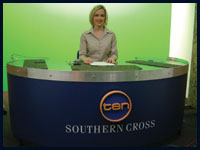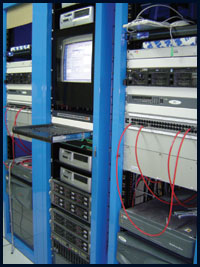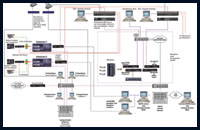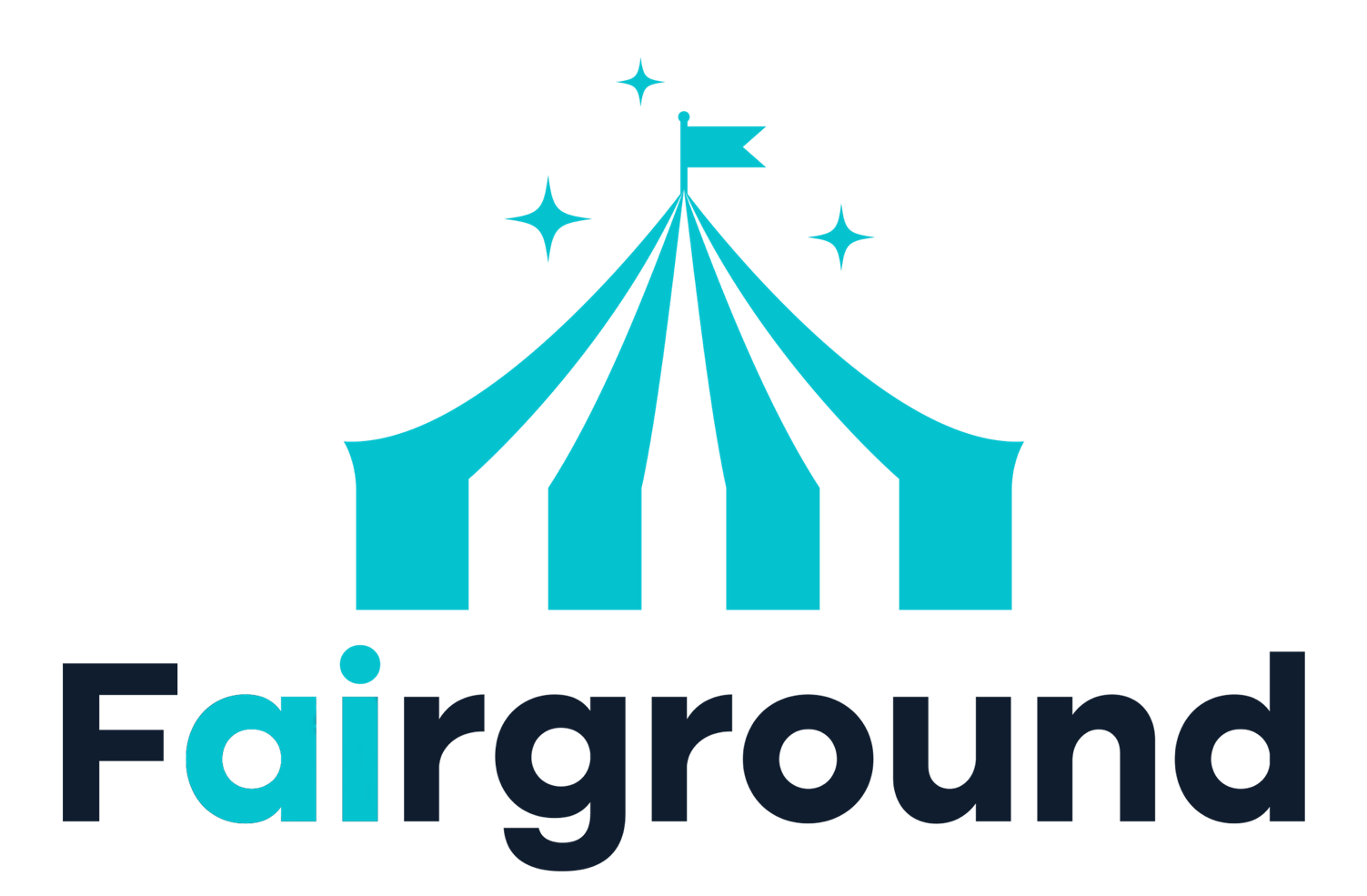Southern Cross Broadcasting
When you first walk into Southern Cross Ten’s new Canberra news facility, you’re struck by the calm ambience and the simplicity of the studio control room. There are two purpose-built studios known as Studio 6 and 7 that glow from the bright Ultimatte lime green rear walls lit by cool fluorescent lighting. Just one control desk houses a minimalistic layout for both studios to provide the operator with direct eye contact to the newsreaders.

Taking scripts directly from ENPS, Cueword generates the prompting for SCB’s newsreaders, who control the prompter speed with a hand controller.
Although there are only two news-readers and one production operator, this facility generates more than 160 news breaks each weekday.
Southern Cross Broadcasting (SCB) launched its nationwide news update operations on 2 February 2004 using networked media solutions from AP ENPS, Cueword, DNF Controls, Masstech Group, Pinnacle Systems, Softel, Ultimatte and Vertigo X Media. The installation was designed, installed and commissioned by Techtel. The operation centers on a production concept using DekoCast video engines and MediaStream 300 servers to produce all the news and weather.
The network required a system that would keep up with the pace and volume of a centralized news operation producing the latest local news for 17 regional markets. Its aim was to rapidly produce contemporary looking updates in a resource-optimized, automated system. The first challenge was to provide the journalists located at eight regional centers across Australia with a full complement of scripting tools and make each system concurrently viewable by the director of news in Canberra. AP’s ENPS version 4 was chosen as the underlying engine. ENPS resides on redundant servers in Canberra, which are networked on the network’s private WAN to the remote offices.

The center rack houses the Vertigo X Media cluster server, ENPS main and back-up servers, and Cueword prompters. The outside racks house the Pinnacle DekoCast video engine and MediaStream servers, Ultimatte 400 chroma keyer, and Softel caption inserter.
While the production requires just three staff members, it’s the editorial control given to the field journalists that make this system so effective. The journalists gather material from local sources. Then they write the stories and insert images and graphics into each script for each news update. Similarly, they enter weather and sponsorship details. One of the unique ENPS features is the intelligent “e-mail by wires” system, which directs incoming stories and attached picture elements to a central storage location as well as the recipient. So to the network’s journalists, it’s all automatic; they can focus on the story, not on the technology.
Get the TV Tech Newsletter
The professional video industry's #1 source for news, trends and product and tech information. Sign up below.
There is no dedicated news graphics department at SCB. Instead, journalists have been trained to use the integrated Vertigo X Media MOS plug-in. Opening within ENPS, the Vertigo Media browser allows journalists to create and select graphics and pictures for over the shoulder (OTS) placement. A menu offers the network’s graphic styles. Effectively, the remote journalist is preparing the material for automated control of the prompter and closed caption system, the rolling of the opener and closer, still-store, character generator, video overlays, DVE, and mixer.
Once the news director in Canberra edits the scripts, the automated production continues. Studio 7, a fully SDI 16:9 suite, uses an Ultimatte 400 chroma keyer. Once on-air, the talent reads and controls the prompter.
In the control room, the desk layout is mirrored for both Studio 6 and 7. Through VGA touchscreens, the operator can control all on-air events, interface and picture monitoring. Gone are the switcher and DVE, character generator keyboard, still store panel, monitors and VTR. Excluding acquisition and archiving, the entire operation is tapeless. Replacing all this equipment is a DekoCast video engine that resides in the rack room and powers the whole show.
With all the pre-production done, Vertigo sends the completed rundown to its control application called Xplay. In place of the traditional multi-panel control desk, the following operational windows appear on a touchscreen SVGA monitor: on-air; pre-view; cue; take; stop rescue; elapsed time; rundown list; available assets; and weather, market and ticker display.

Shown here is an overview of the SCB system.
Xplay controls the DekoCast graphics, DVEs, keys, audio mixes and transitions. The process includes automated clapper generation, electronic countdown and timing. When the technical director clicks on “take,” Vertigo loads DekoCast and progresses through the rundown from top to bottom. DekoCast can produce virtually any on-air look without complex controls. For example, a single operator controlling the “Take next” or “Stop Recue” functions on Vertigo Xplay causes the news update lower frame Super to slide on and off and OTS graphics to transition forward. The whole system is fully automated, accurate and consistent, and it looks polished.
To record the news updates, the Caption inserter output is fed to a pair of mirrored MediaStream 300 servers, which are triggered by a DNF controller. This process ensures that a frame-accurate SOM and EOM are created for the clip without the operator needing to mark any points. The 15Mb/s MPEG-2 long GOP files created on the MediaStream 300 are fully compatible with SCB’s MediaStream 900 SAN playout servers. As the technical director checks the news update, the Masstech MassStore asset management system automatically file transfers the video to the on-air Media-Stream 900 playout servers.
At the same time, MassStore creates an MPEG-4 proxy that’s available to anyone on the SCB WAN for previewing and reviewing on a standard Windows Media player. In the background, a Spectra Logic tape library records and archives the completed news updates. A MassLogger centralized logging program provides a ready means of reviewing content when needed.

Shown here is an overview of the SCB system.
Taking scripts directly from ENPS, Cueword generates the prompting for the newsreader, who controls the prompter speed with a hand controller. Simultaneously, Cueword uses it’s CueCaption driver to send data to a Softel caption inserter. The Softel is wired downstream from the DekoCast to provide embedded closed caption information.
SCB recently deployed 20 Pinnacle Liquid silver NLEs at transcode facilities for the purpose of commercial and CSA production at regional centers. These facilities also can be used to generate news material.
In today’s MOS-based, networked world, reliable and quick content exchange between nonlinear editing, playout servers, newsroom systems, asset management and control devices is paramount. By exploiting the next-generation of technology and methodology, SCB has been able to improve workflow and on-air quality. The process is somewhat invisible, yet in real-time Southern Cross Ten now produces digital news updates with graphics, OTSs, LVOs, automatic weather tickers, transitions, DVEs, audio mixes and 3D weather flyovers — all recorded and aired by a single operator.
Peter Chamberlain is the manager of Techtel.
